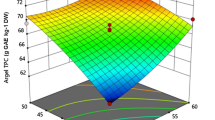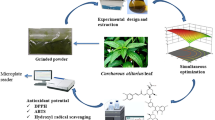Abstract
In recent years, there has been an ever growing interest in finding new natural sources of food antioxidants. As a main fruit crop, olive is also valued due to its phenolic-containing leaves. Mathematically based optimization methods are used as powerful tools to extract different antioxidant compounds. The present study is aimed to provide an efficient extraction method for total phenol content (TPC), total flavonoid content (TFC) and antioxidant ability (DPPH scavenging assay and FRAP). The effects of ultrasonic temperature (35–65 °C), ultrasonic time (5–15 min), and ethanol to water ratio (Et: W) (25–75%) were evaluated. Second-order polynomial models were used through a rotatable Box-Behnken design (BBD) consisting of 15 experimental runs with three replicates at the center point. Interactional effects of the studied factors were significant in most cases for all responses. The highest extraction efficiency was found to be fifty-one percent of ethanol (65 °C, 15 min) to water ratio. Under optimal conditions, values for TPC, TFC, DPPHsc and FRAP assay were 183.4 (mg GAE. g−1 DW), 696.77 (mg Quercetin. g−1 DW), 78.98 (DPPHsc %) and 1942 µmol Fe+2/g DW, respectively. R 2 values (R 2 > 0.92) showed that RSM models could efficiently predict the yield of all responses. In the LC–ESI–MS–DAD profiling of the optimized extract, 27 compounds were identified with oleuropein as the main compound. In the present study, olive leaf is introduced as a promising source of natural antioxidant and can be used in food industries following further studies.




Similar content being viewed by others
References
Abbas S, Hayat K, Karangwa E, Bashari M, Zhang X (2013) An overview of ultrasound-assisted food-grade nanoemulsions. Food Eng Rev 5:139–157
Benzie IF, Strain J (1996) The ferric reducing ability of plasma (FRAP) as a measure of “antioxidant power”: the FRAP assay. Anal Biochem 239:70–76
Box GE, Wilson K (1951) On the experimental attainment of optimum conditions. J R Stat Soc Ser B (Methodol) 13:1–45
Chandrapala J, Leong T (2015) Ultrasonic processing for dairy applications: recent advances. Food Eng Rev 7:143–158
Chemat F, Rombaut N, Sicaire A-G, Meullemiestre A, Fabiano-Tixier A-S, Abert-Vian M (2017) Ultrasound-assisted extraction of food and natural products. Mechanisms, techniques, combinations, protocols and applications. A review. Ultrason Sonochem 34:540–560
Chen C, Shao Y, Tao Y, Wen H (2015a) Optimization of dynamic microwave-assisted extraction of Armillaria polysaccharides using RSM, and their biological activity. Food Sci Technol-LEB 64:1263–1269
Chen M, Zhao Y, Yu S (2015b) Optimisation of ultrasonic-assisted extraction of phenolic compounds, antioxidants, and anthocyanins from sugar beet molasses. Food Chem 172:543–550
Chiou A, Karathanos VT, Mylona A, Salta FN, Preventi F, Andrikopoulos NK (2007) Currants (Vitis vinifera L.) content of simple phenolics and antioxidant activity. Food Chem 102:516–522
Erbay Z, Icier F (2010) The importance and potential uses of olive leaves. Food Rev Int 26:319–334
Fattahi M, Rahimi R (2016) Optimization of extraction parameters of phenolic antioxidants from leaves of Capparis spinosa using response surface methodology. Food Anal Method 9:2321–2334
García-Villalba R, Larrosa M, Possemiers S, Tomás-Barberán F, Espín J (2014) Bioavailability of phenolics from an oleuropein-rich olive (Olea europaea) leaf extract and its acute effect on plasma antioxidant status: comparison between pre-and postmenopausal women. Eur J Nutr 53:1015–1027
Ghanbari R, Anwar F, Alkharfy KM, Gilani A-H, Saari N (2012) Valuable nutrients and functional bioactives in different parts of olive (Olea europaea L.)-a review. Int J Mol Sci 13:3291–3340
Ignat I, Volf I, Popa VI (2011) A critical review of methods for characterisation of polyphenolic compounds in fruits and vegetables. Food Chem 126:1821–1835
Ilaiyaraja N, Likhith K, Babu GS, Khanum F (2015) Optimisation of extraction of bioactive compounds from Feronia limonia (wood apple) fruit using response surface methodology (RSM). Food Chem 173:348–354
Jemai H, Bouaziz M, Fki I, El Feki A, Sayadi S (2008) Hypolipidimic and antioxidant activities of oleuropein and its hydrolysis derivative-rich extracts from Chemlali olive leaves. Chem-Biol Interact 176:88–98
Khiari Z, Makris DP, Kefalas P (2009) An investigation on the recovery of antioxidant phenolics from onion solid wastes employing water/ethanol-based solvent systems. Food Bioprocess Tech 2:337–343
Lee L-S, Lee N, Kim YH, Lee C-H, Hong SP, Jeon Y-W, Kim Y-E (2013) Optimization of ultrasonic extraction of phenolic antioxidants from green tea using response surface methodology. Molecules 18:13530–13545
Liyana-Pathirana C, Shahidi F (2005) Optimization of extraction of phenolic compounds from wheat using response surface methodology. Food Chem 93:47–56
Lobo V, Patil A, Phatak A, Chandra N (2010) Free radicals, antioxidants and functional foods: Impact on human health. Pharmacogn Rev 4:118
Macías-Sánchez M, Mantell C, Rodriguez M, de la Ossa EM, Lubián L, Montero O (2009) Comparison of supercritical fluid and ultrasound-assisted extraction of carotenoids and chlorophyll a from Dunaliella salina. Talanta 77:948–952
Meziant L, Benchikh Y, Louaileche H (2014) Deployment of response surface methodology to optimize recovery of dark fresh fig (Ficus carica L., var. Azenjar) total phenolic compounds and antioxidant activity. Food Chem 162:277–282
Myers WR, Montgomery DC (2003) Response surface methodology. Encycl Biopharm Stat 1:858–869
Nakajima J-i, Tanaka I, Seo S, Yamazaki M, Saito K (2004) LC/PDA/ESI-MS profiling and radical scavenging activity of anthocyanins in various berries. J BioMed Biotech 2004:241–247
Niknam V, Ebrahimzadeh H (2002) Phenolics contents in Astragalus species. Pak J Bot 34:283–289
Omar SH (2010) Oleuropein in olive and its pharmacological effects. Sci Pharm 78:133–154
Özcan MM, Matthäus B (2017) A review: benefit and bioactive properties of olive (Olea europaea L.) leaves. Eur Food Res Technol 243:89–99
Prakash O, Talat M, Hasan S, Pandey RK (2008) Factorial design for the optimization of enzymatic detection of cadmium in aqueous solution using immobilized urease from vegetable waste. Bioresource Technol 99:7565–7572
Prommuak C, De-Eknamkul W, Shotipruk A (2008) Extraction of flavonoids and carotenoids from Thai silk waste and antioxidant activity of extracts. Sep Purif Technol 62:444–448
Puértolas E, Saldana G, Álvarez I, Raso J (2011) Experimental design approach for the evaluation of anthocyanin content of rose wines obtained by pulsed electric fields. Influence of temperature and time of maceration. Food Chem 126:1482–1487
Radojkovića M, Zekovića Z, Jokićb S, Vidovića S (2012) Determination of optimal extraction parameters of mulberry leaves using Response Surface Methodology (RSM). Rom Biotech Lett 17:7295–7308
Şahin S, Şamlı R (2013) Optimization of olive leaf extract obtained by ultrasound-assisted extraction with response surface methodology. Ultrason sonochem 20:595–602
Shi J, Yu J, Pohorly J, Young JC, Bryan M, Wu Y (2003) Optimization of the extraction of polyphenols from grape seed meal by aqueous ethanol solution. J Food Agric Environ 1:42–47
Shin Y, Liu RH, Nock JF, Holliday D, Watkins CB (2007) Temperature and relative humidity effects on quality, total ascorbic acid, phenolics and flavonoid concentrations, and antioxidant activity of strawberry. Postharvest Biol Tec 45:349–357
Silva EM, Rogez H, Larondelle Y (2007) Optimization of extraction of phenolics from Inga edulis leaves using response surface methodology. Sep Purif Technol 55:381–387
Slinkard K, Singleton VL (1977) Total phenol analysis: automation and comparison with manual methods. Am J Enol Viticult 28:49–55
Valko M, Leibfritz D, Moncol J, Cronin MT, Mazur M, Telser J (2007) Free radicals and antioxidants in normal physiological functions and human disease. Int J Biochem Cell Biol 39:44–84
Vinatoru M, Toma M, Radu O, Filip P, Lazurca D, Mason T (1997) The use of ultrasound for the extraction of bioactive principles from plant materials. Ultrason Sonochem 4:135–139
Acknowledgements
Work performed in Department of Department of Plant Biology, College of Science, University of Tehran. The authors are very grateful to the members of “Soil and Water Research Department of Zanjan Agricultural and Natural Resources Research and Education Center” and “Department of Horticulture of Urmia University” for their scientific support in some parts of the present study.
Funding
This study was funded by University of Tehran.
Author information
Authors and Affiliations
Corresponding author
Ethics declarations
Conflict of interest
The authors declare that there is no conflict of interest in this study.
Ethical approval
This article does not contain any studies with human participants performed by any of the authors.
Informed consent
Publication has been approved by all individual participants.
Electronic supplementary material
Below is the link to the electronic supplementary material.
13197_2017_2676_MOESM1_ESM.doc
Analysis of variance (ANOVA) and the estimated regression coefficients for the total phenolic content (TPC), total flavonoid content (TFC), and DPPHsc (%), FRAP. values to determine the suitability of second-order polynomial model fitting in the experimental data (DOC 63 kb)
Rights and permissions
About this article
Cite this article
Shirzad, H., Niknam, V., Taheri, M. et al. Ultrasound-assisted extraction process of phenolic antioxidants from Olive leaves: a nutraceutical study using RSM and LC–ESI–DAD–MS. J Food Sci Technol 54, 2361–2371 (2017). https://doi.org/10.1007/s13197-017-2676-7
Revised:
Accepted:
Published:
Issue Date:
DOI: https://doi.org/10.1007/s13197-017-2676-7




